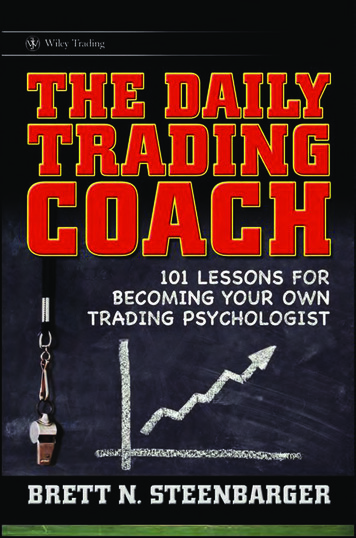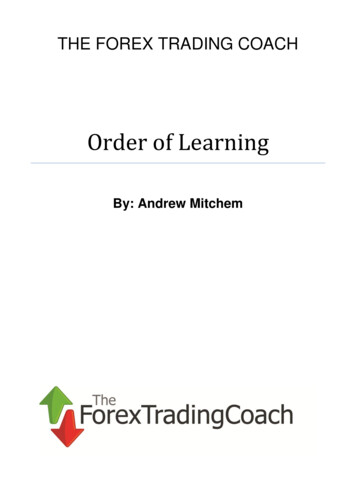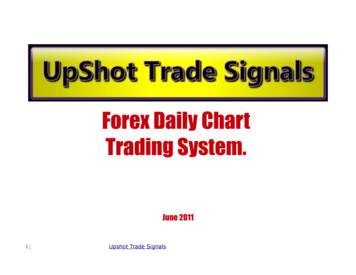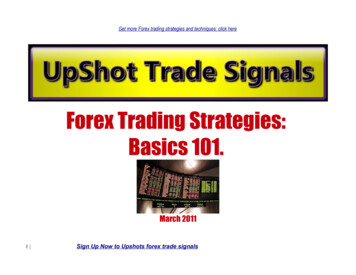
Transcription
P1: JYSfmJWBT039-SteenbargerJanuary 9, 200915:45viPrinter: Yet to come
P1: JYSfmJWBT039-SteenbargerJanuary 9, 200915:45Printer: Yet to comeThe DailyTrading Coachi
P1: JYSfmJWBT039-SteenbargerJanuary 9, 200915:45Printer: Yet to comeFounded in 1807, John Wiley & Sons is the oldest independent publishing company in the United States. With offices in North America, Europe,Australia and Asia, Wiley is globally committed to developing and marketing print and electronic products and services for our customers’ professional and personal knowledge and understanding.The Wiley Trading series features books by traders who have survivedthe market’s ever changing temperament and have prospered—some byreinventing systems, others by getting back to basics. Whether a novicetrader, professional or somewhere in-between, these books will providethe advice and strategies needed to prosper today and well into the future.For a list of available titles, visit our Web site at www.WileyFinance.com.ii
P1: JYSfmJWBT039-SteenbargerJanuary 9, 200915:45Printer: Yet to comeThe DailyTrading Coach101 Lessons for Becoming YourOwn Trading PsychologistBRETT N. STEENBARGERJohn Wiley & Sons, Inc.iii
P1: JYSfmJWBT039-SteenbargerJanuary 9, 200915:45Printer: Yet to comeC 2009 by Brett N. Steenbarger. All rights reserved.Copyright Published by John Wiley & Sons, Inc., Hoboken, New Jersey.Published simultaneously in Canada.No part of this publication may be reproduced, stored in a retrieval system, or transmitted inany form or by any means, electronic, mechanical, photocopying, recording, scanning, orotherwise, except as permitted under Section 107 or 108 of the 1976 United States CopyrightAct, without either the prior written permission of the Publisher, or authorization throughpayment of the appropriate per-copy fee to the Copyright Clearance Center, Inc., 222Rosewood Drive, Danvers, MA 01923, (978) 750-8400, fax (978) 646-8600, or on the web atwww.copyright.com. Requests to the Publisher for permission should be addressed to thePermissions Department, John Wiley & Sons, Inc., 111 River Street, Hoboken, NJ 07030, (201)748-6011, fax (201) 748-6008, or online at http://www.wiley.com/go/permissions.Limit of Liability/Disclaimer of Warranty: While the publisher and author have used their bestefforts in preparing this book, they make no representations or warranties with respect to theaccuracy or completeness of the contents of this book and specifically disclaim any impliedwarranties of merchantability or fitness for a particular purpose. No warranty may be createdor extended by sales representatives or written sales materials. The advice and strategiescontained herein may not be suitable for your situation. You should consult with aprofessional where appropriate. Neither the publisher nor author shall be liable for any loss ofprofit or any other commercial damages, including but not limited to special, incidental,consequential, or other damages.For general information on our other products and services or for technical support, pleasecontact our Customer Care Department within the United States at (800) 762-2974, outside theUnited States at (317) 572-3993 or fax (317) 572-4002.Wiley also publishes its books in a variety of electronic formats. Some content that appears inprint may not be available in electronic books. For more information about Wiley products,visit our web site at www.wiley.com.Library of Congress Cataloging-in-Publication Data:Steenbarger, Brett N.The daily trading coach : 101 lessons for becoming your own trading psychologist /Brett N. Steenbarger.p. cm. – (Wiley trading series)Includes index.ISBN 978-0-470-39856-2 (cloth)1. Stocks–Psychological aspects. 2. Speculation–Psychological aspects.3. Investments–Psychological aspects. 4. Self-help techniques. 5. Personal coaching.I. Title. II. Title: Becoming your own trading psychologist.HG6041.S757 2009332.6 4019–dc222008041524Printed in the United States of America.10987654321iv
P1: JYSfmJWBT039-SteenbargerJanuary 9, 200915:45Printer: Yet to comeWhat? A great man? I always see merelythe play-actor of his own ideal.—Friedrich Nietzschev
P1: JYSfmJWBT039-SteenbargerJanuary 9, 200915:45viPrinter: Yet to come
P1: JYSfmJWBT039-SteenbargerJanuary 9, 200915:45Printer: Yet to tionCHAPTER 11Change: The Process andthe PracticeLesson 1: Draw on Emotion to Become a Change Agent34Lesson 2: Psychological Visibility and Your Relationshipwith Your Trading CoachLesson 3: Make Friends with Your Weakness79Lesson 4: Change Your Environment, Change Yourself11Lesson 5: Transform Emotion by Trace-Formation14Lesson 6: Find the Right Mirrors17Lesson 7: Change Our Focus20Lesson 8: Create Scripts for Life Change23Lesson 9: How to Build Your Self-Confidence25Lesson 10: Five Best Practices for Effecting andSustaining ChangeResourcesCHAPTER 22932Stress and Distress: CreativeCoping for Traders33Lesson 11: Understanding Stress33Lesson 12: Antidotes for Toxic Trading Assumptions37vii
P1: JYSfmJWBT039-SteenbargerJanuary 9, 200915:45Printer: Yet to comeviiiCONTENTSLesson 13: What Causes the Distress That Interfereswith Trading Decisions?Lesson 14: Keep a Psychological Journal4043Lesson 15: Pressing: When You Try Too Hard toMake Money45Lesson 16: When You’re Ready to Hang It Up48Lesson 17: What to Do When Fear Takes Over51Lesson 18: Performance Anxiety: The Most CommonTrading ProblemLesson 19: Square Pegs and Round Holes5458Lesson 20: Volatility of Markets and Volatility ofMood61Resources64CHAPTER 3Psychological Well-Being:Enhancing Trading Experience67Lesson 21: The Importance of Feeling Good67Lesson 22: Build Your Happiness71Lesson 23: Get into the Zone73Lesson 24: Trade with Energy77Lesson 25: Intention and Greatness: Exercise the Brainthrough Play79Lesson 26: Cultivate the Quiet Mind83Lesson 27: Build Emotional Resilience86Lesson 28: Integrity and Doing the Right Thing89Lesson 29: Maximize Confidence and Stay withYour Trades91Lesson 30: Coping—Turn Stress into Well-Being95Resources97CHAPTER 4Steps toward Self-Improvement:The Coaching ProcessLesson 31: Self-Monitor by Keeping a Trading Journal9999Lesson 32: Recognize Your Patterns103Lesson 33: Establish Costs and Benefits to Patterns106Lesson 34: Set Effective Goals109
P1: JYSfmJWBT039-SteenbargerJanuary 9, 200915:45Printer: Yet to comeixContentsLesson 35: Build on Your Best: Maintain a Solution Focus111Lesson 36: Disrupt Old Problem Patterns114Lesson 37: Build Your Consistency by BecomingRule-Governed118Lesson 38: Relapse and Repetition121Lesson 39: Create a Safe Environment for Change123Lesson 40: Use Imagery to Advance the ChangeProcess126Resources130CHAPTER 5Breaking Old Patterns:Psychodynamic Frameworksfor Self-Coaching131Lesson 41: Psychodynamics: Escape the Gravityof Past Relationships132Lesson 42: Crystallize Our Repetitive Patterns135Lesson 43: Challenge Our Defenses138Lesson 44: Once Again, with Feeling: Get Distancefrom Your Problem Patterns141Lesson 45: Make the Most Out of YourCoaching Relationship144Lesson 46: Find Positive Trading Relationships147Lesson 47: Tolerate Discomfort150Lesson 48: Master Transference153Lesson 49: The Power of Discrepancy156Lesson 50: Working Through158Resources161CHAPTER 6Remapping the Mind: CognitiveApproaches to Self-Coaching163Lesson 51: Schemas of the Mind164Lesson 52: Use Feeling to Understand Your Thinking167Lesson 53: Learn from Your Worst Trades170Lesson 54: Use a Journal to Restructure Our Thinking172Lesson 55: Disrupt Negative Thought Patterns176Lesson 56: Reframe Negative Thought Patterns179
P1: JYSfmJWBT039-SteenbargerJanuary 9, 200915:45Printer: Yet to comexCONTENTSLesson 57: Use Intensive Guided Imagery to ChangeThought Patterns182Lesson 58: Challenge Negative Thought Patternswith the Cognitive Journal185Lesson 59: Conduct Cognitive Experiments toCreate Change188Lesson 60: Build Positive Thinking190Resources193CHAPTER 7Learning New Action Patterns:Behavioral Approaches toSelf-Coaching195Lesson 61: Understand Your Contingencies196Lesson 62: Identify Subtle Contingencies199Lesson 63: Harness the Power of Social Learning201Lesson 64: Shape Your Trading Behaviors204Lesson 65: The Conditioning of Markets207Lesson 66: The Power of Incompatibility211Lesson 67: Build on Positive Associations214Lesson 68: Exposure: A Powerful and FlexibleBehavioral MethodLesson 69: Extend Exposure Work to Build Skills217220Lesson 70: A Behavioral Framework for Dealingwith Worry223ResourcesCHAPTER 8226Coaching Your TradingBusiness227Lesson 71: The Importance of Startup Capital227Lesson 72: Plan Your Trading Business231Lesson 73: Diversify Your Trading Business233Lesson 74: Track Your Trading Results236Lesson 75: Advanced Scorekeeping for YourTrading Business240
P1: JYSfmJWBT039-SteenbargerJanuary 9, 200915:45Printer: Yet to comexiContentsLesson 76: Track the Correlations of Your Returns244Lesson 77: Calibrate Your Risk and Reward248Lesson 78: The Importance of Execution in Trading250Lesson 79: Think in Themes—Generating GoodTrading Ideas254Lesson 80: Manage the Trade257Resources259CHAPTER 9Lessons from TradingProfessionals: Resources andPerspectives on Self-Coaching261Lesson 81: Leverage Core Competencies andCultivate Creativity261Lesson 82: I Alone Am Responsible264Lesson 83: Cultivate Self-Awareness271Lesson 84: Mentor Yourself for Success275Lesson 85: Keep Detailed Records279Lesson 86: Learn to Be Fallible283Lesson 87: The Power of Research286Lesson 88: Attitudes and Goals, the Building Blocksof Success290Lesson 89: A View from the Trading Firms295Lesson 90: Use Data to Improve Trading Performance300Resources305CHAPTER 10 Looking for the Edge: FindingHistorical Patterns in Markets307Lesson 91: Use Historical Patterns in Trading308Lesson 92: Frame Good Hypotheses with the Right Data310Lesson 93: Excel Basics313Lesson 94: Visualize Your Data317Lesson 95: Create Your Independent andDependent VariablesLesson 96: Conduct Your Historical Investigations320324
P1: JYSfmJWBT039-SteenbargerJanuary 9, 200915:45xiiPrinter: Yet to comeCONTENTSLesson 97: Code the Data327Lesson 98: Examine Context329Lesson 99: Filter Data332Lesson 100: Make Use of Your Findings334Resources336CONCLUSION339Lesson 101: Find Your Path339For More on Self-Coaching341About the Author343Index345
P1: JYSfmJWBT039-SteenbargerJanuary 9, 200915:45Printer: Yet to comePrefacehe goal of The Daily Trading Coach is to teach you as much as possible about coaching, so that you can mentor yourself to success in thefinancial markets. The key word in the title is “Daily.” This book is designed to be a resource that you can use every day to build upon strengthsand overcome weaknesses.After writing two books—The Psychology of Trading and EnhancingTrader Performance—and penning more than 1,800 posts for the TraderFeed blog (www.traderfeed.blogspot.com/), I thought I had pretty well covered the terrain of trading psychology. Now, just three years after the publication of the performance book, I’ve once again taken electronic pen topaper, completing a trading psychology trilogy by focusing on the processof coaching.Two realities led to The Daily Trading Coach. First, a review of thetraffic patterns on the TraderFeed blog revealed that a large number ofreaders—about a third—were accessing the site during the hour or so immediately prior to the market open. I found this interesting, as most of theposts do not offer specific trading advice. Rather, posts deal with topics ofpsychology and performance—ones that should be relevant at any hour ofthe day.When I asked a group of trusted readers about this pattern, they responded that they were using the blog as a kind of surrogate tradingcoach. Reviewing the posts was their way of reminding themselves of theirplans and intentions before going entering the financial battlefield. Thiswas confirmed when I gathered statistics about the most popular (and commented upon) posts on the blog. The majority were practical posts dealingwith trading psychology. Most were uplifting in content, even as they challenged the assumptions of readers. It seemed as though traders were looking for coaching and finding some measure of it in the blog.The second reality shaping this book involves digital publication andthe rapid changes sweeping the publishing world. To this point, relativelyfew electronic books (e-books) have been offered to traders. When thosebooks are available, they are little more than screen versions of the printTxiii
P1: JYSfmJWBT039-SteenbargerxivJanuary 9, 200915:45Printer: Yet to comePREFACEtext. Despite the allure and convenience of electronic publishing, fewtraders I consulted actually sought out or used e-books. The most commoncomplaint among traders was that they did not want to spend hours devouring information in front of a screen after a full day of trading. I quicklyrealized that participants in the financial markets don’t use the electronicmedium in the same way that they engage print text. That led me to thinkabout writing a different kind of book, one better suited to publishing’selectronic frontier, but also useable in print.When you overlay these two observations, you can appreciate the vision that led to this text: a “trading coach in a book” that can be as easilyread on the screen as on paper. The goal was to integrate blog and bookcontent by creating practical “lessons” that help traders become their owntrading coaches. There are 101 lessons in The Daily Trading Coach, averaging several pages in length. Each lesson follows a general format, identifying a trading challenge, an approach to meeting that challenge, and aspecific suggestion or assignment for working on the issue. The chaptersare independent of one another: you can read them in order, or you can usethe table of contents or index to read, each day, the lesson that most applies to your current trading. Unlike a traditional book, the idea is not toread it through from front to back in
The daily trading coach : 101 lessons for becoming your own trading psychologist / Brett N. Steenbarger. p. cm. – (Wiley trading series) Includes index. ISBN 978-0-470-39856-2 (cloth) 1. Stocks–Psychological aspects. 2. Speculation–Psychological aspects. 3. Investments–Psychological aspects. 4. Self-help techniques. 5. Personal coaching. I. Title. II. Title: Becoming your own trading .











